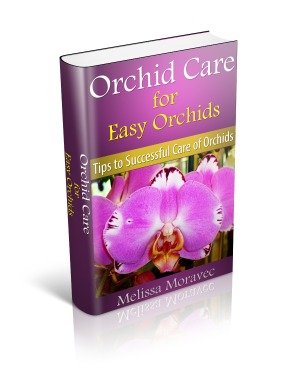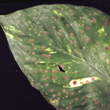Learn About Orchid Diseases and What To Do When Your Orchid Is Sick.
Orchid Diseases
Orchids have been cultivated for some time as a result there are some orchid diseases to consider. Compared to many plants like tomatoes and potatoes orchids have few diseases and only a few pests. If you want to check out orchid pests like mites - Check here.
The real trick with orchid care is to gain some experience and education and to be preventive with respect to problems. It helps to learn about orchid diseases. It really doesn't take much time or knowledge to keep orchids healthy.
Frequently people write me and ask me to recommend resources or sources of information to learn about orchids. My current favorite e-book is the one I have recently completed.

It is called Orchid Care for Easy Orchids Tips for Successful Care of Orchids. It is about 37 pages long and it is filled with a lot of great information on how to grow and bloom 5 kinds of "easy to grow" orchids. If you are interested I have listed it on the Kindle bookstore. This is the only way it can be purchased is through Amazon, as I had to agree not to sell it for at least 90 days while listing it on Kindle Books.
Click on the image below to check it out!
I own about 20 hard orchid books and over 5 orchid e-books. I like different books for different reasons. But this is the one I would suggest to start with right now whether you are a new orchid grower or have some experience.
Ok Let's Look At Orchid Diseases!
Orchid Diseases can be roughly divided into these groups: Orchid diseases that are bacterial, fungal, viral and from pests. In all of these cases it is important to pay attention and to be diligent if any action is needed. This attention and quick action is important to the health and thriving of your orchid plants.
I suggest that you check your orchids weekly for any signs of orchid diseases or trouble. The earlier a problem is discovered the easier it is to effectively treat the problem.
Orchid Diseases: Bacterial Problems:
Bacterial ailments often come from the genus Erwinia or Pseudomonas cattleyae. Often bacterial infections are encouraged by too high a humidity or not sufficient air circulation. Orchids are more susceptible to bacterial infections wehn the growing conditions are cool and moist. This helps the bacteria to grow.

One common bacteria problem is known as "brown spot". This is a serious infection and can kill your plant. It can be identified by a brown blister that looks somewhat "watery" located on one of the leaves. The blister enlarges and can infect the whole leaf and the tissue can become wet and soggy as it rots enlarge quickly and soon, the whole leaf will become infected. If the infection reachs the crown of the plant, it will likely be fatal. Phalaenopsis orchids are particularly prone to getting crown rot. If a plant is infected it is important to keep the infection from spreading both on the individual plant and to other plants in your collection. Remove the infected parts with a new, sterile single edged razor blade. It is recommended to treat with a chemical like Physan which is effective on both bacteria and fungus.
Orchid Diseases: Fungal Problems:
Fungus on orchids can cause a lot of problems and can be serious. If not properly treated they can lead to rot, yellow leaves and orchid death. The best way to prevent fungal infections is to control the conditions that favor the growth of fungi in the first place.
Orchid diseases from fungal problems can come from a number of different organisms. Black Rot is often caused by Phytophthora. The grey molds are usually Botrytis cinerea. Root rots come most often from the Pythium and Phytophthora.
Black Rot can develop in orchid roots and leaves. It is promoted by letting the plant sit in water or if the orchid media has decomposed enough to rot. There are soft rotted areas on the leaves, new growths and sometimes the roots. Once it spreads to the roots, the lifeline of a healthy orchid plant it can be fatal.
Named for its color the leaves will turn brown and then black. As with a bacterial infection treat by cutting the infected area off past the infected area and into the healthy tissue. It is important to use sterile technique in between cuts if one is cutting infected plant material. Or use new single edged razor blades and discard the blade if it has been used on the rotted material. Do not use a blade on rotted material and then cut healthy material or you will just spread the disease. Use a fungicide like Physan on the cut areas of the plant.
Leaf Spot is a fungus that affects injured leaves. It is on of the causes of yellow leaves. It starts on the underside and then can spread to the top of the leaf. It can look like very small roundish brown sunken spots. Treatment is to remove the badly damaged leaves and treat with a fungicide.
Root Rot will sap the life of the plant over a period of months before it dies. The leaves may appear droopy and stunted. Brown-black areas are seen in the roots and the roots are often clearly rotten or missing. Sometimes the leaves will be twisted and yellowed. Treat root rot by cutting off all rotted and infected areas, sterilizing your cutting tool after every cut (or use a new single edged razor blade) as previously described. Discard all the old potting medium, cut the rotten roots away treat with a fungicide and repot with new potting material and a new sterile pot. Reduce water for a while after repotting until the orchid has recouperated.
Another common fungal disease is petal blight. This causes an orchid flower to develop spots. It happens when water is allowed to collect on the surfaces of the flowers. If this is the case, you will need to use a fungicide. And it is important to increase the air circulation around the plants and to decrease the humidity levels. Removing the infected flowers will help reduce the spread of the disease. If your plant is affected with petal blight, you will need to apply fungicide to get rid of the problem. You should also increase air circulation and decrease the humidity levels. It's also best if you remove flowers that have been infected. This will reduce the likelihood of this orchid disease spreading.
Ways to Prevent Fungal Infections:
Try not to water orchids on cool, cloudy days and try to avoid over watering. Provide good air circulation. Re-pot before the growing medium has decayed. If you do get a fungal infection treat it promptly and prevent it from infecting other plants.
Orchid Diseases: Viral Problems:
Some orchid diseases are caused by a virus. Viral infections are much harder to diagnose. Its important to monitor your plants for diseases affecting orchids because they can spread from plant to plant, and kill all of your plants.

Orchid viruses are not that common. Over 20 different viral diseases have been identified in orchids. Viral infections, unlike bacterial and fungus infections are invisible. It may take some time to notice that your plant is ill and that something is affecting its health. The symptoms of an orchid virus are hard to detect at first and can look like other diseases. Sometimes there is a modeling of the tissue or a slight yellowish or white streaking. Later, they may be brown pitting on the leaf. Unlike fungus and bacterial infections the damage is systemic. It is not merely on the surface, it will appear to penetrate the leaf tissue. Viral infections are easily spread through contact of fluids. Insect vectors can spread a viral infection, as well as using unsterilized tools when working with your orchids.
Here are some tips to avoid spreading orchid viruses.
Always choose healthy plants. Always use sterile cutting tools when cutting leaves or flowers, and when re-potting your orchid plants. Use clean latex gloves when re-potting and working with your plants. Use a new pair of gloves for each plant. When watering water orchids individually. Do not use a single bucket to soak multiple plants. When re-potting orchids and re-pot them individually. Work on one plant at a time. One trick is to work on newspaper and discard the spent growing medium and the newspaper in between plants.
A viral infection is serious for orchids. They may be able to live for a very long time, but they can infect other orchids in your collection.
Many commercial growers advise you to dispose of virus or could, rather than keep it. But I think as a hobbyist. It's probably alright keep a virus planted your collection. If you are aware that there is the possibility of infecting some other plants.
Until recently the most accurate way to test for viral infection was to send a tissue sample to a lab for analysis. Now virus home testing kits are also available , and they are becoming more reliable.


